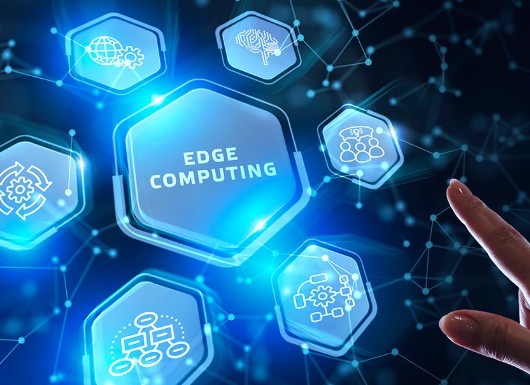Edge computing (EC) is a new network architecture and open platform that integrates network, computing, storage, and application core capabilities at the edge of the network close to people, things, or data sources. Edge computing combines traditional centralized cloud computing processing Instead, computing and storage capabilities are moved down to the edge of the network to provide edge intelligent services nearby in a user- and terminal-oriented manner. Edge computing greatly reduces the congestion and burden on the core network and transmission network caused by data backhaul. It achieves lower latency, brings higher bandwidth, and can quickly respond to user requests and improve service quality. Currently, edge computing has become an important enabling technology in the future fifth-generation communications (5G) era, and has been written into the third-generation Partner Program (3rd generation partnership project, 3GPP) standard. More and more operators, equipment vendors, and chip manufacturers are joining the ranks of building an edge computing ecosystem. How to create a unified and standardized edge computing platform is critical to the construction of the future edge ecosystem. It is crucial. Therefore, we will focus on the current progress of edge computing standardization, starting from the European Telecommunications Standards Institute (ETSI) first proposing the edge computing architecture, to 3GPP incorporating edge computing into the key technology of future 5G development, and then Go to the project establishment and research of edge computing in China Communications Standards Association (CCSA). Each part of the introduction arranges a lot of analysis and explanation of the standard content. Finally, it introduces China Unicom’s edge computing in recent years. Research results include important edge computing pilots, China Unicom’s future edge computing pilot plan, and exploration of edge computing network deployment solutions. We hope to discuss edge computing business cooperation models with the industry, jointly build a network edge ecosystem, and comprehensively promote 5G services. of vigorous development.

The 5G network is deeply integrated with cloud computing, big data, virtual augmented reality, artificial intelligence and other technologies, and will connect people and everything, becoming a key infrastructure for the digital transformation of various industries. 5G includes three major application scenarios; enhance mobile broadband , eMBB), massive machine type of communication (mMTC) and ultrahigh reliability low delay communication (uRLLC). Among them, eMBB focuses on services with extremely high bandwidth requirements, such as ultra-high definition video , virtual reality (VR) and augmented reality (AR), etc., meet people’s needs for digital life; mMTC focuses on businesses that require higher connection density, such as smart cities, smart agriculture, smart homes, etc. To meet people’s needs for a digital society; uRLLC focuses on businesses that are extremely sensitive to latency, such as autonomous driving, industrial control, telemedicine, etc., to meet people’s needs for digital industry. Some of them are such as autonomous driving, telemedicine, AR/VR, etc. Applications have latency requirements of milliseconds. According to estimates from the Cisco Global Cloud Index, by 2019, 45% of the data generated by the Internet of Things will be stored, processed, and analyzed at the edge of the network, and the total number of global data centers will be Data traffic is expected to reach 10.4 zettabytes (ZB) (1ZB=27B). The latest statistical report from the International Data Corporation (IDC) shows that by 2020, more than 50 billion terminals and devices will be connected to the Internet.Edge computing gateway
The traditional cloud computing model, also known as centralized data processing with cloud computing as the core, transmits data to a remote cloud computing center, and the results of data processing and analysis are then transmitted back to the user end. This kind of Cloud computing centers have strong computing and storage capabilities, and cloud computing capabilities are also growing linearly year by year. However, in the face of such explosive growth of massive data generated at the edge of the network in the future, the current traditional cloud computing model will be seriously challenged. .First of all, these
Massive data needs to be transmitted back through the operator’s network and processed by the core network, which is a very big challenge for the current operator’s transmission network and core network. In the future, the transmission of massive data will require a large bandwidth. The processing and transmission capabilities of the network can easily cause congestion; on the other hand, the delay caused by the transmission of massive data is also very large, which will greatly reduce the user experience. In addition, for the security issues of massive data transmission and terminal energy consumption The problem cannot be ignored. The operator’s network will not be redeployed in the short term. Therefore, there is an urgent need to find a more reasonable way to solve the existing problem [2.
Edge computing (EC) is a new network architecture and open platform that integrates network, computing, storage, and application core capabilities at the edge of the network close to people, things, or data sources. It provides edge intelligent services nearby to meet the digitalization of the industry. Key requirements in terms of agile connections, real-time services, data optimization, application intelligence, security and privacy protection. Edge computing is a concept of near computing, which brings computing closer to the local network where the data source is located, as much as possible. There is no need to transmit data back to the cloud, reducing the waiting time and network costs for data to and from the cloud. Edge computing migrates intensive computing tasks to nearby network edge servers, reducing congestion and burden on the core network and transmission network, and alleviating network bandwidth pressure. Achieve lower latency, bring higher bandwidth, improve data processing efficiency in the era of Internet of Everything, and at the same time be able to quickly respond to user requests and improve service quality.